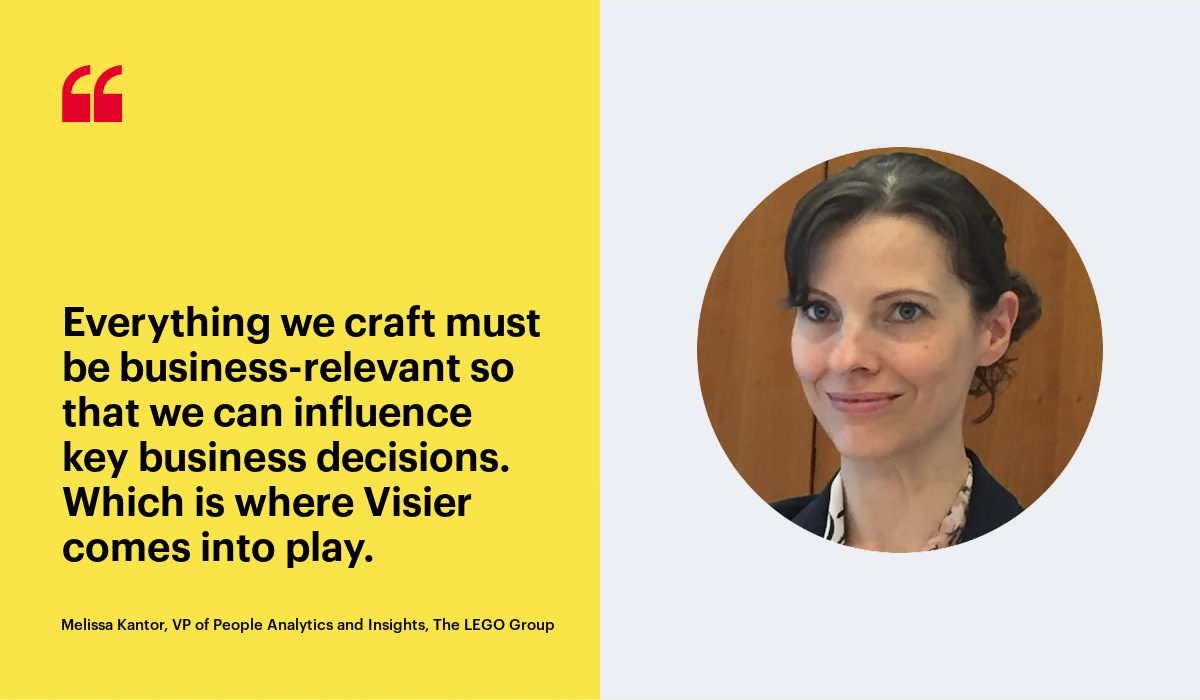How The LEGO Group is Embracing People-Powered Digital Transformation
In this webinar recap, learn how the LEGO Group’s VP of People Analytics and Insights unlocked the power of people analytics for business transformation.

The LEGO Group’s VP of People Analytics and Insights, Melissa Kantor, and Ian Cook, Visier’s VP of People Analytics, joined Kate Graham for an Unleash webinar discussion exploring how they unlocked the power of people analytics.
In 1932, Ole Kirk Kristiansen built his first wooden toy, the “building block” of what would eventually become the LEGO Group, a beloved, kid-pleasing toy icon with more than 20K employees in 40+ countries. The company has come a long way since the first toy was carved by hand. Today, the LEGO Group is a powerhouse of ventures which support a more creative and resilient society. This dedication to creativity and resilience shows in their willingness to change as the business needs change.
Recently, the LEGO group embraced digital transformation across the entire company to modernise the business. In the HR function, this digital transformation includes ‘influence’, what Melissa Kantor calls the next step beyond ‘analytics by design’—enabling the people function to participate in the highest level of strategic business conversations within the organisation, and affect their outcomes. If people are the building blocks of the company, HR should inform and influence business decisions.
“Everything we craft must be business-relevant so that we can influence key business decisions. Which is where Visier comes into play.”—Melissa Kantor. The LEGO Group.

It’s not about having perfect data or the most expensive HRIS vendor, it’s about changing the mindset of the entire company so that different levels of leadership get used to thinking of people data as a way to answer everyday questions and give real answers. To do this, she had to first change a few habits.
People analytics as a base plate
When Melissa joined The LEGO Group the HR team had been charged with modernising the HR aspects of the business, before the overall digital transformation programme began. She quickly realised that there was good information within the systems, but that it was difficult to extract.
“Unfortunately, we sometimes see businesses trying to produce charts and reports for reasons they are not quite sure about, or for their own sake.” Ian Cook, Visier.

The group wanted to understand what data they had, its quality, where the gaps were, what was being captured, and what wasn’t. This was a way they felt they could start delivering value to the business, even before the firmwide transformation effort.
The LEGO Group is somewhat unusual, says Ian, in that it’s embedding the right people analytics in organisational design and function as part of its transformation. It’s a marker that sets them apart, because it’s using people analytics with a focused intention to make something happen, prior and during fundamental change, not as a layer on top of whatever is going on day-to-day.
The ‘complete data’ folly
For people analytics functions, it’s important to distinguish between seeking to understand what data you have, and the fool’s errand that can be trying to fix or complete that data. A common misconception, especially for inexperienced teams, is that it’s important to have complete data, or have all the data in one place.
“We might call this a twentieth century IT way of thinking,” says Ian. “Modern technology presents different, better ways of approaching the problem. You used to have to stitch together three or four pieces of tech to make some of these data flows work, which was arduous. Now it’s all available as a stack in the cloud.”
The analytics group needs to comment on the quality of data being used, not ‘own’ the task of becoming the guardian of the data, or cleansing the data. If the people analytics team takes ownership of the data, they immediately risk becoming an HR operations function rather than an analytics team.
“There is no such thing as perfect data, you just need to have good enough data, and understand what ‘good enough’ is,” says Melissa.
One way of checking the quality or accuracy of a result, when data is in question, is to run some analysis in a controlled environment where you are certain you have good data, even if it’s a small subset of the whole. Compare your findings with the broader group to see where you can have confidence in your recommendations and where they need caveats due to gaps in the data.
Level up your training and development
Another example of an area where people analytics can support and illuminate business activity around real business outcomes is the efficacy of training and development. Are your investments in training and development paying off?
“In every place I’ve ever worked,” says Melissa, “we have all these training and development initiatives, and what the people sponsoring or paying for them want to know is: are these people being promoted?”
To answer such questions definitively, from a people analytics standpoint, it’s important to separate correlation from causation. It might be that the people who received the training would have been promoted anyway, for example. Ask the question through three different data sets though, and you’ll be able to see, and report on, what is really going on.
A better HRIS: some assembly required
Without focus on what measurements a business needs, switching to a new HRIS system can be like switching from a too-small green block to an identical yellow block in the middle of a LEGO construction–takes a lot of effort but doesn’t solve the core issue. Many organisations have finished off their HRIS implementation only to find they are not in a better place with regard to their ability to answer key business questions. This is not the case at The LEGO Group, where the people analytics team have championed a deep focus on data from across multiple systems so that the business is able to access the insights it needs.
“I’m lucky to have people on my team who are tough,” says Melissa. “Always asking if X is being captured, so we’re going to be able to report on Y.”
The LEGO Group has a Workday implementation currently in progress, replacing an old SAP system as its core HR solution. The insights gained from deploying people analytics have been invaluable in reducing the risks associated with a new system implementation.
“It’s not just the systems you buy,” says Ian, “but how you set them up. Time to promotion or diversity information is not going to be available from any system if it’s set up incorrectly in terms of the analytics, or left on ‘bland’ factory default settings.”
Adoption: Change management brick by brick
Laying the foundations alone is not success. Even a successful people analytics software implementation means very little, unless you can get people to adopt, learn, and use the system themselves. People analytics leaders are in the business of making new habits and breaking some old ones. The LEGO Group achieved this by mandating that people logged in and used the systems, even if it was for simple functions.
“It may sound a bit extreme, but you have to set expectations early on,” says Melissa. “That thing about ‘build it and they will come’ doesn’t work with a greenfield people analytics system within a busy organisation. It can feel a bit contrived to begin with, but you have to be strong and push through. Do this, and confidence gradually builds, then you are on your way to the maturity phase, which is where we are now.”
The LEGO Group people analytics team now has people leaders extracting data to run their own analyses. This is the ‘pull’ from the organisation that people analytics teams and their sponsors must work towards if they are to harvest the dividends of people powered transformation.
Data democratisation is also important. “We’ve opened data to all our people managers,” says Melissa. “They can see all the data for the teams they manage and reach out to newly data-savvy people partners for further guidance or interpretation.” Opening Visier to the senior leadership group has also led to a further, positive ‘pull’ on the analytics team, for help with insights that will support strategic decision making.

The world’s biggest brands rely on Visier for the answers they need to improve employee retention, workforce diversity, employee experience, business outcomes, and more. See how Visier customers solve business problems with people analytics.
Get the Outsmart newsletter
You can unsubscribe at any time. For more information, check out Visier's Privacy Statement.


